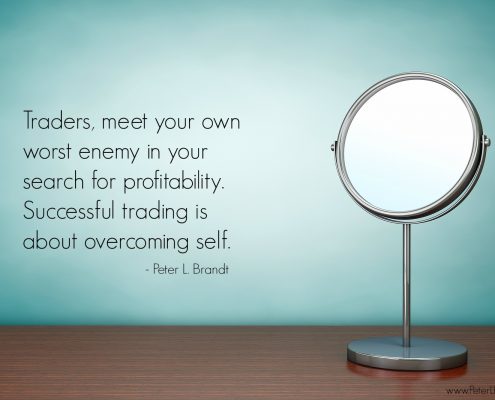Trading Psychology – The Human Side of Trading
I was recently asked on one of our monthly webinars how I handled trading around periods of draw-downs. In particular, the member asking the question said they were in a nasty drawdown that lasted a few months, but that there was a glimmer of light at the end of the tunnel because recent trades were performing so well. The dilemma was that he now had an itchy finger to take profits before those targets were hit, as experience told him that it doesn’t take much for a sudden retracement to cut his profits in half. Fear was warring with his plan, and it had become emotionally tiring. Of course this is a classic question on Trading Psychology and the Human Side of Trading, a question far too few traders ask of themselves.
Let me guess two things from the question. First, my guess is that the drawdown was deeper than it should have been and that it consisted of at least several trades that went from initial profits into losses. Because of this fact he is now fearful of present profits turning into losses. Second, my guess is that the member had not as buttoned up on rules and guidelines for managing open trades as he would like to be – and this fact makes it easier to second guess the outcomes of each and every trading event.
He asked if this situation ever happens to me. The answer — When doesn’t it happen to me? Welcome to the world of Trading Psychology and discretionary trading. I wish I could sound brilliant in answering the question, but unfortunately the war he describes is not one for which I will ever claim complete victory. Human emotions are the biggest enemy a trader faces. This is one reason I am so critical of the self-proclaim “geniuses” who peddle trade identification and win rates as the pinnacle of trading achievement. Unfortunately, there are no easy answers to this dilemma – and each discretionary trader must find ways to win individual battles within the larger war against self. I am not even sure that the specific “peace treaties” I have negotiated over the years with my inner enemies are the best solutions for all other traders.

Overcoming self and mastering Trading Psychology is an individual struggle – this is why consistent long-term traders have developed a tremendous and unbiased awareness of self. When I came into the trading business in the mid-1970s there was a saying around the Chicago Board of Trade that went something like this … “If you want to know yourself – all your insecurities, character faults, issues of pride, areas of greed or selfishness, unresolved traits, etc. – just become a trader. How true! Self-awareness and managing the Human Side of Trading is a hallmark of every great trader I have known over the years.I can describe some of the steps I have used to create a peace treaty with fear, false hope and greed.
- De-emphasize open trade profits and focus on an equity curve based on sequential outcomes of closed trades.
- Become an obsessed monster in managing losses during trading drawdowns so that the eventual hole I will need to dig out of is manageable – this will then make it easier to allow subsequent winning trades some room and time to develop.
- Trade multiple contract positions and take some money off the table quickly on a portion of a theme. While this strategy reduces my long- term bottom line, it does moderate asset volatility and increase my staying power with the portion of a position which I hold for bigger gains.
- Continue to refine “best practice” rules and guidelines for trade management and constantly remind myself of their purposes and intended outcomes.
- Remove myself from monitoring markets intraday – thus, negating short-term emotional urges.
- Focus on the process of trading and not on individual results.
- Remain convinced (as I should) that optimizing trade outcomes is IMPOSSIBLE.
Traders who do not have specific trade management rules and guidelines face the biggest emotional turmoil because it becomes so easy for them to second-guess every decision – and this leads to the vicious cycle:
- “I took profits too early and left a ton on the table – and now regret my decision”
- “I did not take profits and the trade was a popcorn kernel – and now regret my decision”
- And on and on it goes
The reality of trade management is that rules, guidelines and decisions CANNOT be optimized. If you come up with all the answers to this trading dilemma, please let me know.
Peter Brandt is a 40+ year veteran of trading. Through his Factor Service, members receive:

Trading Commodity Futures with Classical Chart Patterns: A free PDF copy of Peter’s classic out-of-print book

Weekend Update: 10-16 pages full of in-depth chart analysis and charting commentary

Alerts: Detailed information on specific charts as unique opportunities present themselves

Market Commentaries: Communications on specific topics regarding market speculation and trading distributed periodically

Webinars: Monthly member-only webinars where Peter speaks about current conditions and fields member questions

Knowledge Center: Fast and easy access to current and archived content from Peter’s extensive library of content

Automatic notifications: Email and social media notifications are sent out when new content is published
View your Factor Member options here.
You could consider your membership in the Factor Service as just one more trade. If the Factor Service is not of value to you, well, it is just one more trade that did not work. Through the Factor Service I endeavor to alert novice and aspiring traders to the many pitfalls you will face – and to offer advice on overcoming those pitfalls. My goal is to shoot straight on what trading is all about. For more information watch my 30 minute webinar where we cover the Factor service in depth.
I hope you will consider joining the Factor community.










